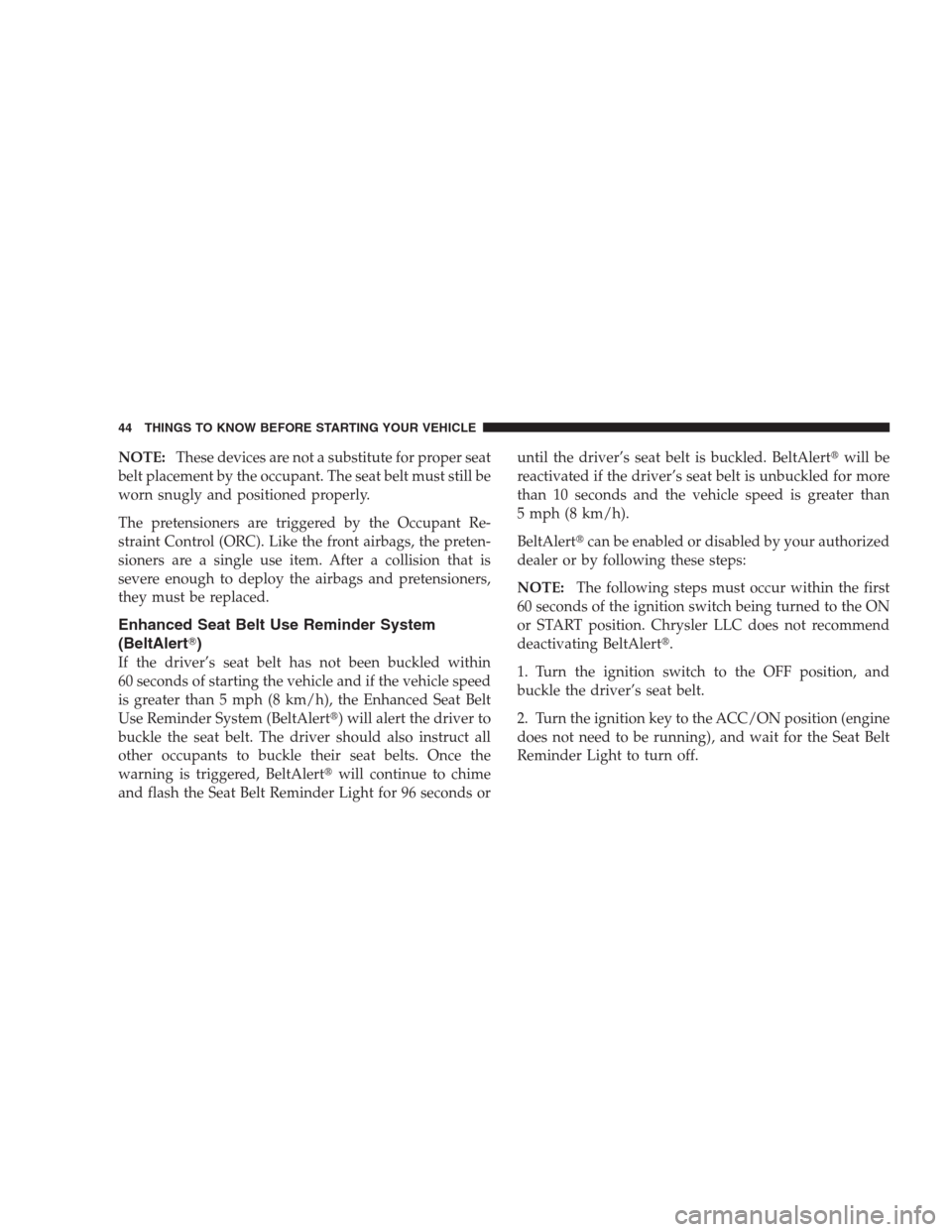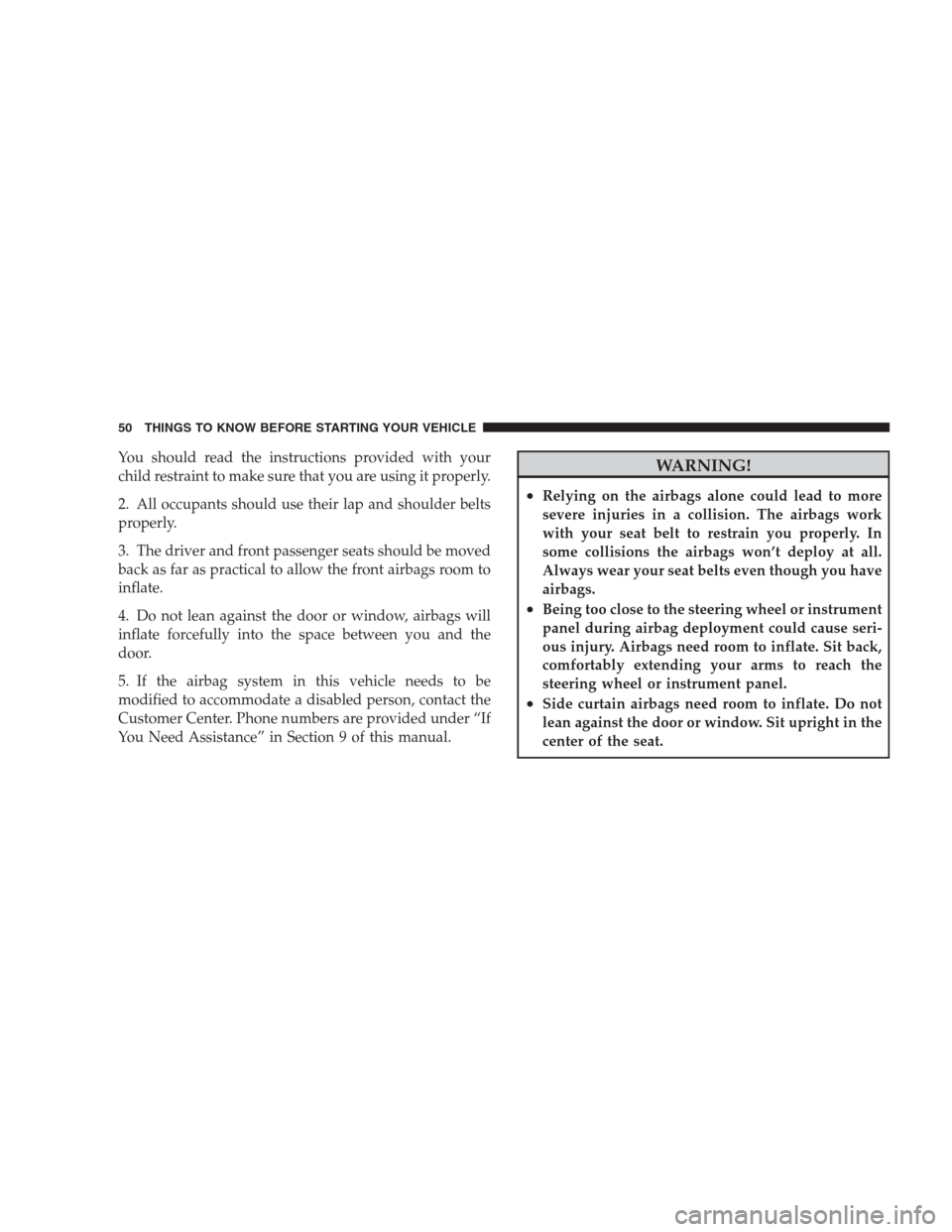Page 46 of 521

NOTE:These devices are not a substitute for proper seat
belt placement by the occupant. The seat belt must still be
worn snugly and positioned properly.
The pretensioners are triggered by the Occupant Re-
straint Control (ORC). Like the front airbags, the preten-
sioners are a single use item. After a collision that is
severe enough to deploy the airbags and pretensioners,
they must be replaced.
Enhanced Seat Belt Use Reminder System
(BeltAlert�)
If the driver’s seat belt has not been buckled within
60 seconds of starting the vehicle and if the vehicle speed
is greater than 5 mph (8 km/h), the Enhanced Seat Belt
Use Reminder System (BeltAlert�) will alert the driver to
buckle the seat belt. The driver should also instruct all
other occupants to buckle their seat belts. Once the
warning is triggered, BeltAlert�will continue to chime
and flash the Seat Belt Reminder Light for 96 seconds oruntil the driver’s seat belt is buckled. BeltAlert�will be
reactivated if the driver’s seat belt is unbuckled for more
than 10 seconds and the vehicle speed is greater than
5 mph (8 km/h).
BeltAlert�can be enabled or disabled by your authorized
dealer or by following these steps:
NOTE:The following steps must occur within the first
60 seconds of the ignition switch being turned to the ON
or START position. Chrysler LLC does not recommend
deactivating BeltAlert�.
1. Turn the ignition switch to the OFF position, and
buckle the driver’s seat belt.
2. Turn the ignition key to the ACC/ON position (engine
does not need to be running), and wait for the Seat Belt
Reminder Light to turn off.
44 THINGS TO KNOW BEFORE STARTING YOUR VEHICLE
Page 52 of 521

You should read the instructions provided with your
child restraint to make sure that you are using it properly.
2. All occupants should use their lap and shoulder belts
properly.
3. The driver and front passenger seats should be moved
back as far as practical to allow the front airbags room to
inflate.
4. Do not lean against the door or window, airbags will
inflate forcefully into the space between you and the
door.
5. If the airbag system in this vehicle needs to be
modified to accommodate a disabled person, contact the
Customer Center. Phone numbers are provided under “If
You Need Assistance” in Section 9 of this manual.WARNING!
•Relying on the airbags alone could lead to more
severe injuries in a collision. The airbags work
with your seat belt to restrain you properly. In
some collisions the airbags won’t deploy at all.
Always wear your seat belts even though you have
airbags.
•Being too close to the steering wheel or instrument
panel during airbag deployment could cause seri-
ous injury. Airbags need room to inflate. Sit back,
comfortably extending your arms to reach the
steering wheel or instrument panel.
•Side curtain airbags need room to inflate. Do not
lean against the door or window. Sit upright in the
center of the seat.
50 THINGS TO KNOW BEFORE STARTING YOUR VEHICLE
Page 58 of 521

Airbag Warning Light
You will want to have the airbag system ready to inflate
for your protection in an impact. The airbag system is
designed to be maintenance free. If any of the following
occurs, have an authorized dealer service the system
promptly:
•Airbag Warning Light does not come on during the six
to eight seconds after the ignition switch is first turned
on,
•Remains on after the six to eight second interval, or
•Flickers, or comes on and remains on for any period of
time while driving.
NOTE:If the speedometer, tachometer, or any engine
related gauges are not working, the airbag control mod-
ule may also be disabled. The airbags may not be ready
to inflate for your protection. Promptly check the fuseblock for blown fuses. Refer to “Fuses” in Section 7 of this
manual. See your authorized dealer if the fuse is good.
Event Data Recorder (EDR)
In the event of an accident, your vehicle is designed to
record up to five seconds of specific vehicle data param-
eters (see the following list) in an event data recorder
prior to the moment of airbag deployment, or near
deployment, and up to one-quarter second of high-speed
deceleration data during and/or after airbag deployment
or near-deployment. EDR data are ONLY recorded if an
airbag deploys, or nearly deploys, and are otherwise
unavailable.
NOTE:
•A near-deployment event occurs when the airbag
sensor detects severe vehicle deceleration usually in-
dicative of a crash, but not severe enough to warrant
airbag deployment.
56 THINGS TO KNOW BEFORE STARTING YOUR VEHICLE
Page 60 of 521

4. Otherwise required by law.
Data parameters that may be recorded:
•Diagnostic trouble code(s) and warning lamp status
for electronically-controlled safety systems, including
the airbag system
•Airbag disable lamp status (if equipped)
•�Time�of airbag deployment (in terms of ignition
cycles and vehicle mileage)
•Airbag deployment level (if applicable)
•Impact acceleration and angle
•Seat belt status
•Brake status (service and parking brakes)
•Accelerator status (including vehicle speed)
•Engine control status (including engine speed)
•Transmission gear selection
•Cruise control status
•Traction/stability control status
•Tire Pressure Monitoring System status
Child Restraints
Everyone in your vehicle needs to be buckled up all the
time — babies and children, too. Every state in the United
States, and all Canadian provinces, require that small
children ride in proper restraint systems. This is the law,
and you can be prosecuted for ignoring it.
Children 12 years and under should ride properly buck-
led up in a rear seat, if available. According to crash
statistics, children are safer when properly restrained in
the rear seats rather than in the front.
There are different sizes and types of restraints for
children from newborn size to the child almost large
58 THINGS TO KNOW BEFORE STARTING YOUR VEHICLE